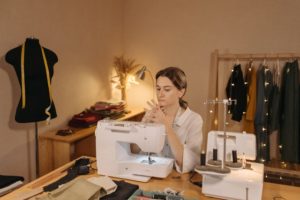Sewing is a hobby that many people enjoy. Whether you are an expert seamstress or just getting started, you can review a talk about sewing tables to find the best and all of the supplies you need. If you have a small living area or apartment, here are some tips and tricks for sewing in a small space.
Flexibility is Key
 One of the best things about sewing is that it can be done in a small space. If you are short on room, try to use a fold-up table or put your machine on a shelf so you can quickly move it out of the way when not in use. Another option is to use a wall-mounted table – this will free up a lot of floor space and is also very convenient if you like to work in front of the TV. If your apartment doesn’t allow wall mounting, try using an extra chair as support or even use another table.
One of the best things about sewing is that it can be done in a small space. If you are short on room, try to use a fold-up table or put your machine on a shelf so you can quickly move it out of the way when not in use. Another option is to use a wall-mounted table – this will free up a lot of floor space and is also very convenient if you like to work in front of the TV. If your apartment doesn’t allow wall mounting, try using an extra chair as support or even use another table.
Storage is Everything
One of the biggest challenges when sewing in a small space is finding storage for all of your supplies. Try to find creative solutions, like using a shoe rack to store fabric or baskets and bins to organize your tools. If you have room, consider investing in a vertical storage unit – this will help you make use of every inch of space! Some sewing experts even have a room in their house meant only for crafting to make full use of all the storage.
Stitching in the Kitchen
If you are short on space, another option is to move your sewing machine into the kitchen. This might not be ideal for everyone, but it can work if you have no other options. The great thing about stitching in the kitchen is that you already have all the necessary supplies – a table, chairs, and lots of counter space. If you choose to sew in the kitchen, try using a drop cloth or table cover so that accidental spills don’t ruin any projects.
Keep it Small
 If you are starting with sewing, or don’t do it very often, try to keep your supplies to a minimum. This will not only save you space, but it will also make it easier to transport your machine and materials wherever you go. Try to stick to the basics – fabric, scissors, pins, needles, and thread. You can always add more supplies as you become more experienced. When it comes to your machine, try to find a small and lightweight model.
If you are starting with sewing, or don’t do it very often, try to keep your supplies to a minimum. This will not only save you space, but it will also make it easier to transport your machine and materials wherever you go. Try to stick to the basics – fabric, scissors, pins, needles, and thread. You can always add more supplies as you become more experienced. When it comes to your machine, try to find a small and lightweight model.

